University Essay: Ottawa Charter, Health Promotion, and Nursing Role
VerifiedAdded on 2022/09/13
|9
|2223
|15
Essay
AI Summary
This essay explores the application of the Ottawa Charter for Health Promotion to the Australian National Diabetes Strategy, focusing on the Aboriginal and Torres Strait Islander (ATSI) population. It analyzes how the strategy addresses the charter's six action areas, emphasizing health literacy, health education, and health promotion to empower this vulnerable group. The essay discusses the role of nurses in facilitating community-based health education, promoting patient advocacy, and improving diabetes management through culturally competent approaches. It also highlights the importance of family involvement and regular blood glucose screening in reducing health inequalities and improving health outcomes. The essay concludes that while the strategy aligns with the Ottawa Charter, further efforts are needed to improve health literacy and reduce diabetes prevalence within the ATSI population, emphasizing the ongoing role of nurses in promoting comprehensive health promotion.
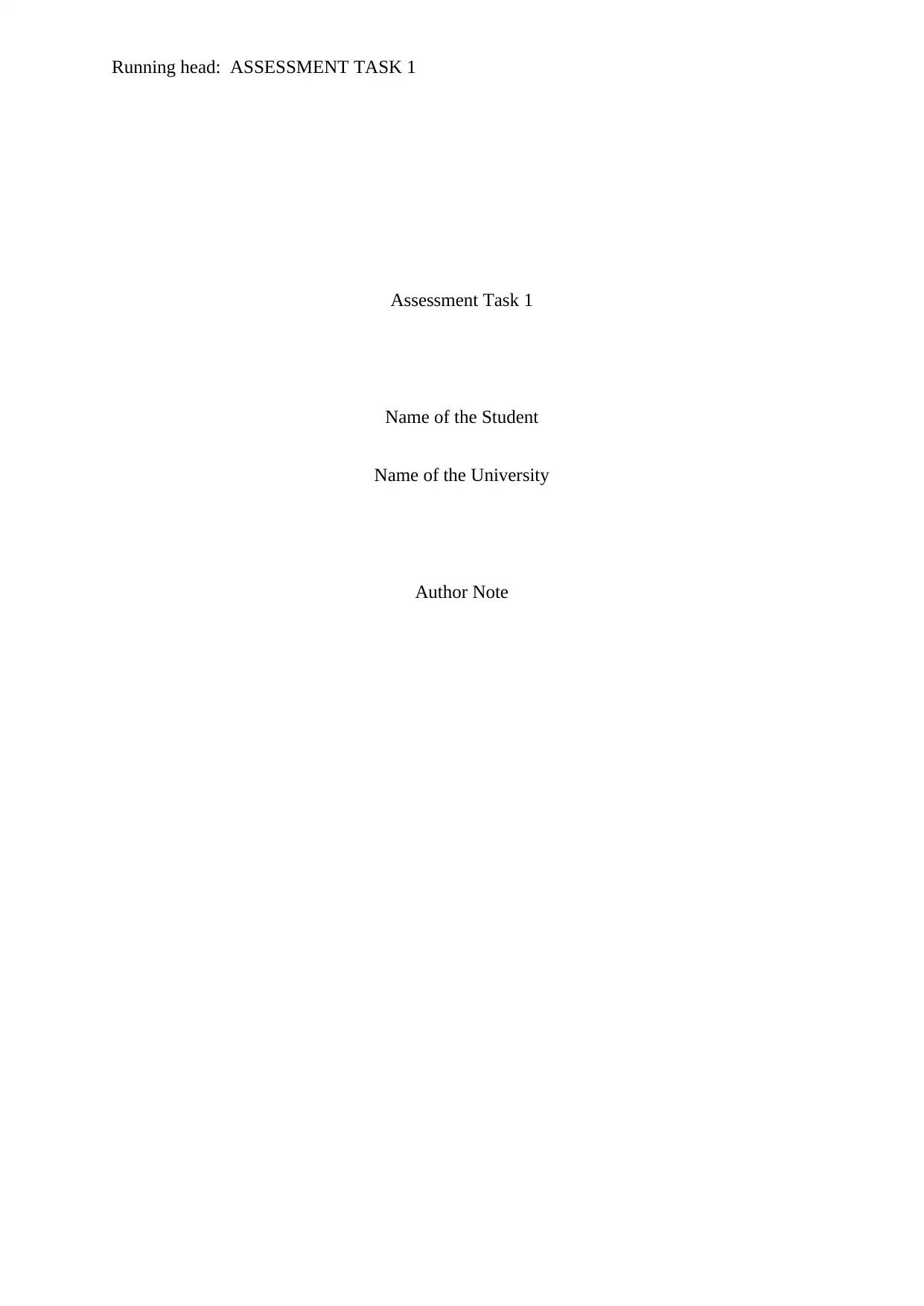
Running head: ASSESSMENT TASK 1
Assessment Task 1
Name of the Student
Name of the University
Author Note
Assessment Task 1
Name of the Student
Name of the University
Author Note
Paraphrase This Document
Need a fresh take? Get an instant paraphrase of this document with our AI Paraphraser

1
ASSESSMENT TASK 1
Introduction
The foundation of Ottawa Charter for Health Promotion in the year 1986 lead to the
beginning of the change in a manner through which the healthcare professionals empower
and educate the individuals and other community members (World Health Organization or
WHO, 2019). The following essay aims to demonstrate by personal understandings of how
the Australian National Diabetes Strategy is addressing the principal action areas of the
Ottawa Charter health promotion strategy in regards to the Aboriginals and Torres Strait
Islander (ATSI) population. The essay will also focus on how health literacy, health
education and health promotion help in empowering the ATSI population and the role of
nurse in healthcare service user’s empowerment.
Ottawa Charter of Health Promotion Strategy
According to the Ottawa Charter for the Health Promotion (OCHP), health promotion
is defined as a process that helps people to increase their control over their health status and
thereby helping to improve their overall health-related quality of life. The main action areas
of the OCHP include: health advocacy, ensuring equal opportunities in healthcare,
mediated co-ordinated actions by the other stakeholder of health, building public health
policy, creation of supportive environment, strengthening community-based actions,
development of the personal skills and re-orientation of the healthcare services (WHO,
2019).
Australian National Diabetes Strategy (ANDS) and OCHP
Australian National Diabetes Strategy mainly aims of outline the national response of
Australia toward effective prevention of diabetes and at the same time helps to inform the
importance of the existing healthcare resources in order to promote comprehensive health
ASSESSMENT TASK 1
Introduction
The foundation of Ottawa Charter for Health Promotion in the year 1986 lead to the
beginning of the change in a manner through which the healthcare professionals empower
and educate the individuals and other community members (World Health Organization or
WHO, 2019). The following essay aims to demonstrate by personal understandings of how
the Australian National Diabetes Strategy is addressing the principal action areas of the
Ottawa Charter health promotion strategy in regards to the Aboriginals and Torres Strait
Islander (ATSI) population. The essay will also focus on how health literacy, health
education and health promotion help in empowering the ATSI population and the role of
nurse in healthcare service user’s empowerment.
Ottawa Charter of Health Promotion Strategy
According to the Ottawa Charter for the Health Promotion (OCHP), health promotion
is defined as a process that helps people to increase their control over their health status and
thereby helping to improve their overall health-related quality of life. The main action areas
of the OCHP include: health advocacy, ensuring equal opportunities in healthcare,
mediated co-ordinated actions by the other stakeholder of health, building public health
policy, creation of supportive environment, strengthening community-based actions,
development of the personal skills and re-orientation of the healthcare services (WHO,
2019).
Australian National Diabetes Strategy (ANDS) and OCHP
Australian National Diabetes Strategy mainly aims of outline the national response of
Australia toward effective prevention of diabetes and at the same time helps to inform the
importance of the existing healthcare resources in order to promote comprehensive health
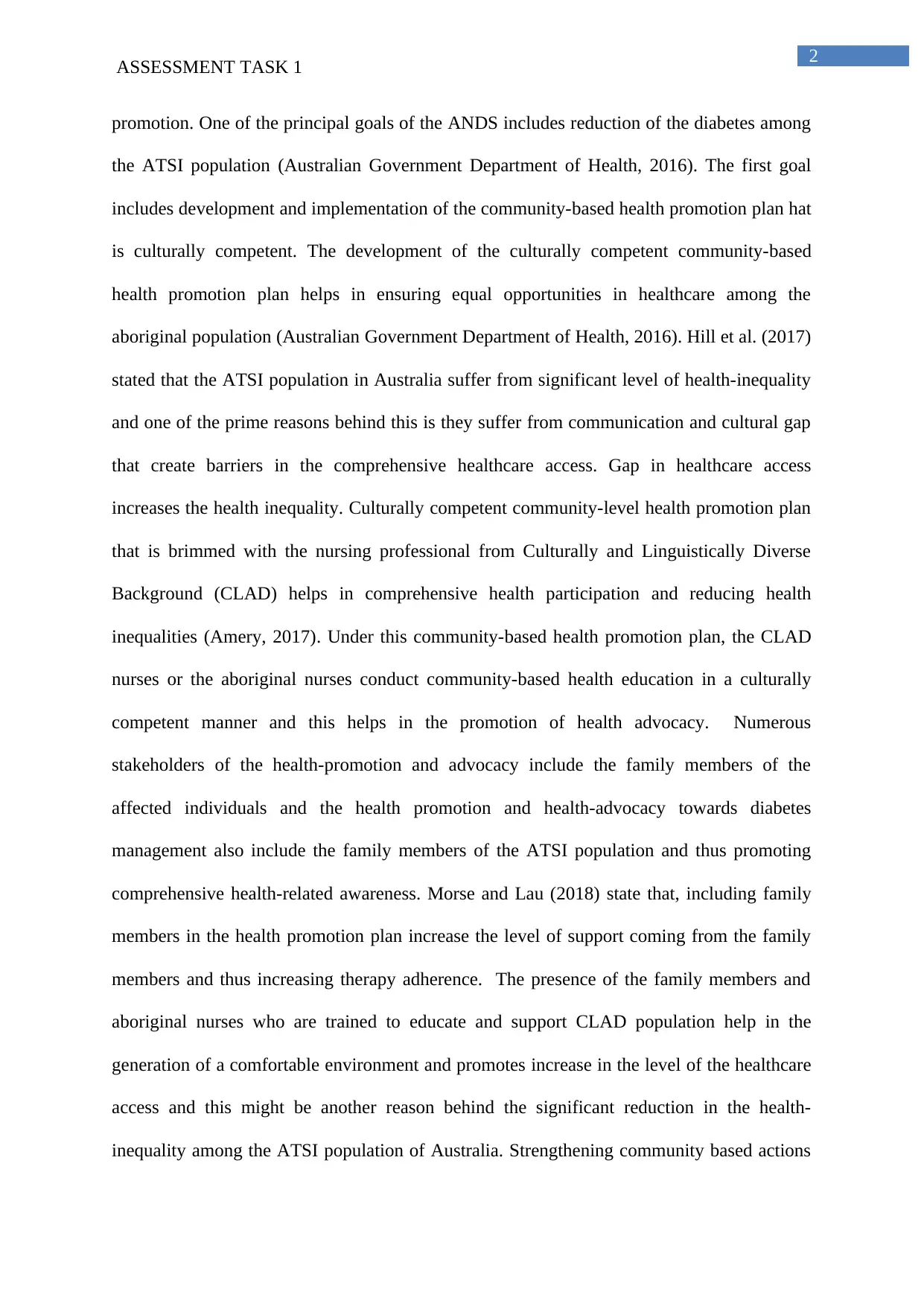
2
ASSESSMENT TASK 1
promotion. One of the principal goals of the ANDS includes reduction of the diabetes among
the ATSI population (Australian Government Department of Health, 2016). The first goal
includes development and implementation of the community-based health promotion plan hat
is culturally competent. The development of the culturally competent community-based
health promotion plan helps in ensuring equal opportunities in healthcare among the
aboriginal population (Australian Government Department of Health, 2016). Hill et al. (2017)
stated that the ATSI population in Australia suffer from significant level of health-inequality
and one of the prime reasons behind this is they suffer from communication and cultural gap
that create barriers in the comprehensive healthcare access. Gap in healthcare access
increases the health inequality. Culturally competent community-level health promotion plan
that is brimmed with the nursing professional from Culturally and Linguistically Diverse
Background (CLAD) helps in comprehensive health participation and reducing health
inequalities (Amery, 2017). Under this community-based health promotion plan, the CLAD
nurses or the aboriginal nurses conduct community-based health education in a culturally
competent manner and this helps in the promotion of health advocacy. Numerous
stakeholders of the health-promotion and advocacy include the family members of the
affected individuals and the health promotion and health-advocacy towards diabetes
management also include the family members of the ATSI population and thus promoting
comprehensive health-related awareness. Morse and Lau (2018) state that, including family
members in the health promotion plan increase the level of support coming from the family
members and thus increasing therapy adherence. The presence of the family members and
aboriginal nurses who are trained to educate and support CLAD population help in the
generation of a comfortable environment and promotes increase in the level of the healthcare
access and this might be another reason behind the significant reduction in the health-
inequality among the ATSI population of Australia. Strengthening community based actions
ASSESSMENT TASK 1
promotion. One of the principal goals of the ANDS includes reduction of the diabetes among
the ATSI population (Australian Government Department of Health, 2016). The first goal
includes development and implementation of the community-based health promotion plan hat
is culturally competent. The development of the culturally competent community-based
health promotion plan helps in ensuring equal opportunities in healthcare among the
aboriginal population (Australian Government Department of Health, 2016). Hill et al. (2017)
stated that the ATSI population in Australia suffer from significant level of health-inequality
and one of the prime reasons behind this is they suffer from communication and cultural gap
that create barriers in the comprehensive healthcare access. Gap in healthcare access
increases the health inequality. Culturally competent community-level health promotion plan
that is brimmed with the nursing professional from Culturally and Linguistically Diverse
Background (CLAD) helps in comprehensive health participation and reducing health
inequalities (Amery, 2017). Under this community-based health promotion plan, the CLAD
nurses or the aboriginal nurses conduct community-based health education in a culturally
competent manner and this helps in the promotion of health advocacy. Numerous
stakeholders of the health-promotion and advocacy include the family members of the
affected individuals and the health promotion and health-advocacy towards diabetes
management also include the family members of the ATSI population and thus promoting
comprehensive health-related awareness. Morse and Lau (2018) state that, including family
members in the health promotion plan increase the level of support coming from the family
members and thus increasing therapy adherence. The presence of the family members and
aboriginal nurses who are trained to educate and support CLAD population help in the
generation of a comfortable environment and promotes increase in the level of the healthcare
access and this might be another reason behind the significant reduction in the health-
inequality among the ATSI population of Australia. Strengthening community based actions
⊘ This is a preview!⊘
Do you want full access?
Subscribe today to unlock all pages.

Trusted by 1+ million students worldwide
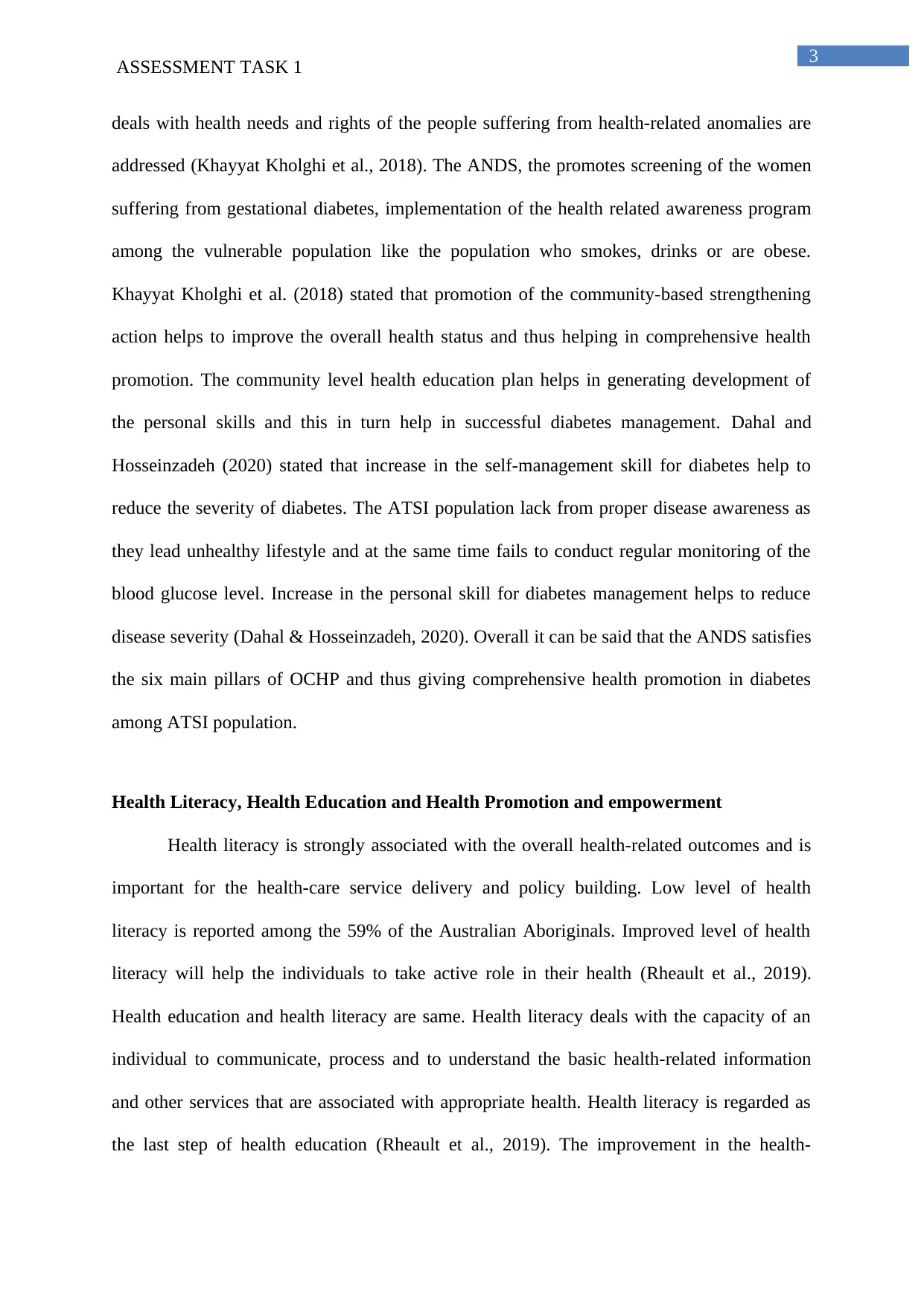
3
ASSESSMENT TASK 1
deals with health needs and rights of the people suffering from health-related anomalies are
addressed (Khayyat Kholghi et al., 2018). The ANDS, the promotes screening of the women
suffering from gestational diabetes, implementation of the health related awareness program
among the vulnerable population like the population who smokes, drinks or are obese.
Khayyat Kholghi et al. (2018) stated that promotion of the community-based strengthening
action helps to improve the overall health status and thus helping in comprehensive health
promotion. The community level health education plan helps in generating development of
the personal skills and this in turn help in successful diabetes management. Dahal and
Hosseinzadeh (2020) stated that increase in the self-management skill for diabetes help to
reduce the severity of diabetes. The ATSI population lack from proper disease awareness as
they lead unhealthy lifestyle and at the same time fails to conduct regular monitoring of the
blood glucose level. Increase in the personal skill for diabetes management helps to reduce
disease severity (Dahal & Hosseinzadeh, 2020). Overall it can be said that the ANDS satisfies
the six main pillars of OCHP and thus giving comprehensive health promotion in diabetes
among ATSI population.
Health Literacy, Health Education and Health Promotion and empowerment
Health literacy is strongly associated with the overall health-related outcomes and is
important for the health-care service delivery and policy building. Low level of health
literacy is reported among the 59% of the Australian Aboriginals. Improved level of health
literacy will help the individuals to take active role in their health (Rheault et al., 2019).
Health education and health literacy are same. Health literacy deals with the capacity of an
individual to communicate, process and to understand the basic health-related information
and other services that are associated with appropriate health. Health literacy is regarded as
the last step of health education (Rheault et al., 2019). The improvement in the health-
ASSESSMENT TASK 1
deals with health needs and rights of the people suffering from health-related anomalies are
addressed (Khayyat Kholghi et al., 2018). The ANDS, the promotes screening of the women
suffering from gestational diabetes, implementation of the health related awareness program
among the vulnerable population like the population who smokes, drinks or are obese.
Khayyat Kholghi et al. (2018) stated that promotion of the community-based strengthening
action helps to improve the overall health status and thus helping in comprehensive health
promotion. The community level health education plan helps in generating development of
the personal skills and this in turn help in successful diabetes management. Dahal and
Hosseinzadeh (2020) stated that increase in the self-management skill for diabetes help to
reduce the severity of diabetes. The ATSI population lack from proper disease awareness as
they lead unhealthy lifestyle and at the same time fails to conduct regular monitoring of the
blood glucose level. Increase in the personal skill for diabetes management helps to reduce
disease severity (Dahal & Hosseinzadeh, 2020). Overall it can be said that the ANDS satisfies
the six main pillars of OCHP and thus giving comprehensive health promotion in diabetes
among ATSI population.
Health Literacy, Health Education and Health Promotion and empowerment
Health literacy is strongly associated with the overall health-related outcomes and is
important for the health-care service delivery and policy building. Low level of health
literacy is reported among the 59% of the Australian Aboriginals. Improved level of health
literacy will help the individuals to take active role in their health (Rheault et al., 2019).
Health education and health literacy are same. Health literacy deals with the capacity of an
individual to communicate, process and to understand the basic health-related information
and other services that are associated with appropriate health. Health literacy is regarded as
the last step of health education (Rheault et al., 2019). The improvement in the health-
Paraphrase This Document
Need a fresh take? Get an instant paraphrase of this document with our AI Paraphraser
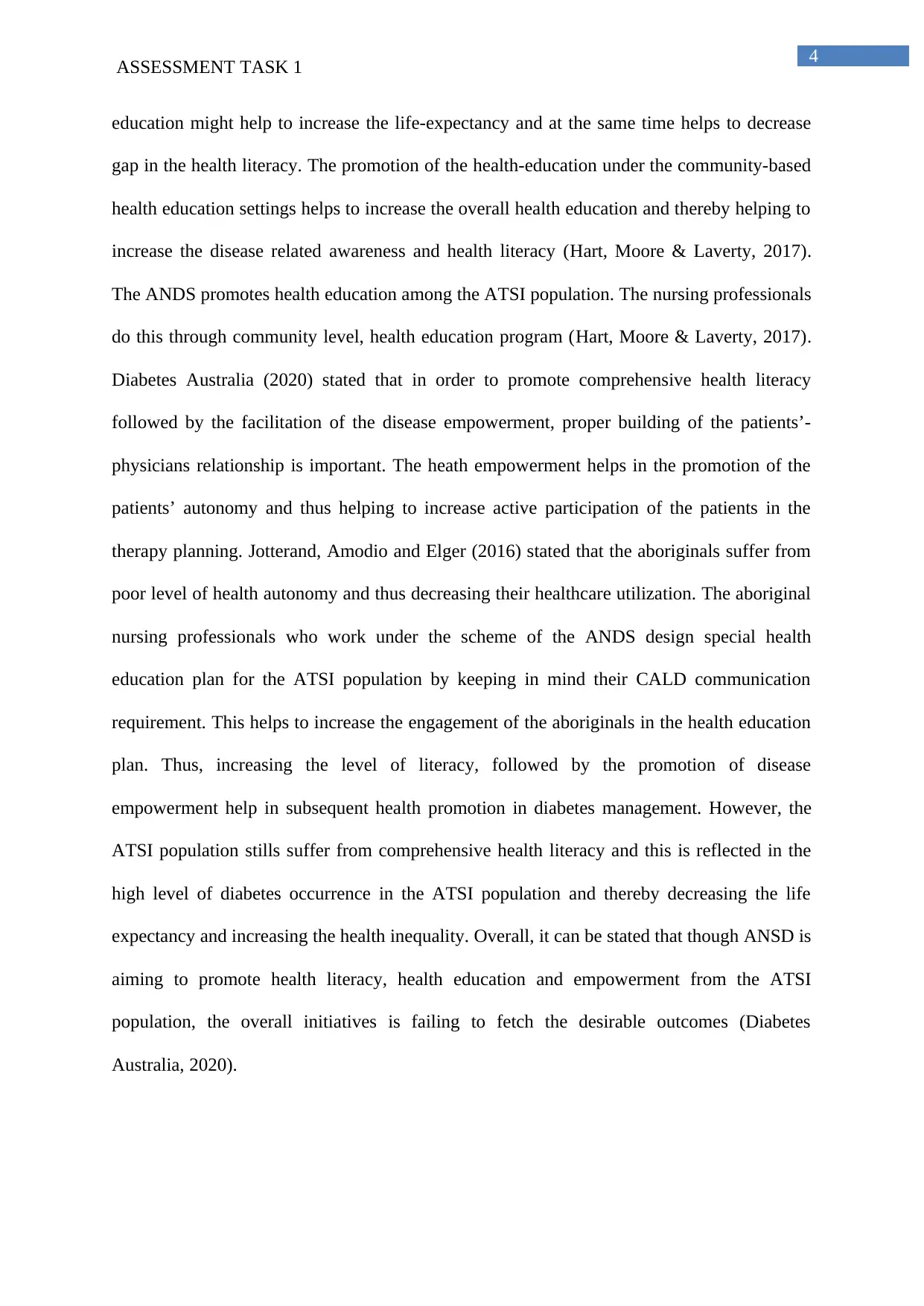
4
ASSESSMENT TASK 1
education might help to increase the life-expectancy and at the same time helps to decrease
gap in the health literacy. The promotion of the health-education under the community-based
health education settings helps to increase the overall health education and thereby helping to
increase the disease related awareness and health literacy (Hart, Moore & Laverty, 2017).
The ANDS promotes health education among the ATSI population. The nursing professionals
do this through community level, health education program (Hart, Moore & Laverty, 2017).
Diabetes Australia (2020) stated that in order to promote comprehensive health literacy
followed by the facilitation of the disease empowerment, proper building of the patients’-
physicians relationship is important. The heath empowerment helps in the promotion of the
patients’ autonomy and thus helping to increase active participation of the patients in the
therapy planning. Jotterand, Amodio and Elger (2016) stated that the aboriginals suffer from
poor level of health autonomy and thus decreasing their healthcare utilization. The aboriginal
nursing professionals who work under the scheme of the ANDS design special health
education plan for the ATSI population by keeping in mind their CALD communication
requirement. This helps to increase the engagement of the aboriginals in the health education
plan. Thus, increasing the level of literacy, followed by the promotion of disease
empowerment help in subsequent health promotion in diabetes management. However, the
ATSI population stills suffer from comprehensive health literacy and this is reflected in the
high level of diabetes occurrence in the ATSI population and thereby decreasing the life
expectancy and increasing the health inequality. Overall, it can be stated that though ANSD is
aiming to promote health literacy, health education and empowerment from the ATSI
population, the overall initiatives is failing to fetch the desirable outcomes (Diabetes
Australia, 2020).
ASSESSMENT TASK 1
education might help to increase the life-expectancy and at the same time helps to decrease
gap in the health literacy. The promotion of the health-education under the community-based
health education settings helps to increase the overall health education and thereby helping to
increase the disease related awareness and health literacy (Hart, Moore & Laverty, 2017).
The ANDS promotes health education among the ATSI population. The nursing professionals
do this through community level, health education program (Hart, Moore & Laverty, 2017).
Diabetes Australia (2020) stated that in order to promote comprehensive health literacy
followed by the facilitation of the disease empowerment, proper building of the patients’-
physicians relationship is important. The heath empowerment helps in the promotion of the
patients’ autonomy and thus helping to increase active participation of the patients in the
therapy planning. Jotterand, Amodio and Elger (2016) stated that the aboriginals suffer from
poor level of health autonomy and thus decreasing their healthcare utilization. The aboriginal
nursing professionals who work under the scheme of the ANDS design special health
education plan for the ATSI population by keeping in mind their CALD communication
requirement. This helps to increase the engagement of the aboriginals in the health education
plan. Thus, increasing the level of literacy, followed by the promotion of disease
empowerment help in subsequent health promotion in diabetes management. However, the
ATSI population stills suffer from comprehensive health literacy and this is reflected in the
high level of diabetes occurrence in the ATSI population and thereby decreasing the life
expectancy and increasing the health inequality. Overall, it can be stated that though ANSD is
aiming to promote health literacy, health education and empowerment from the ATSI
population, the overall initiatives is failing to fetch the desirable outcomes (Diabetes
Australia, 2020).
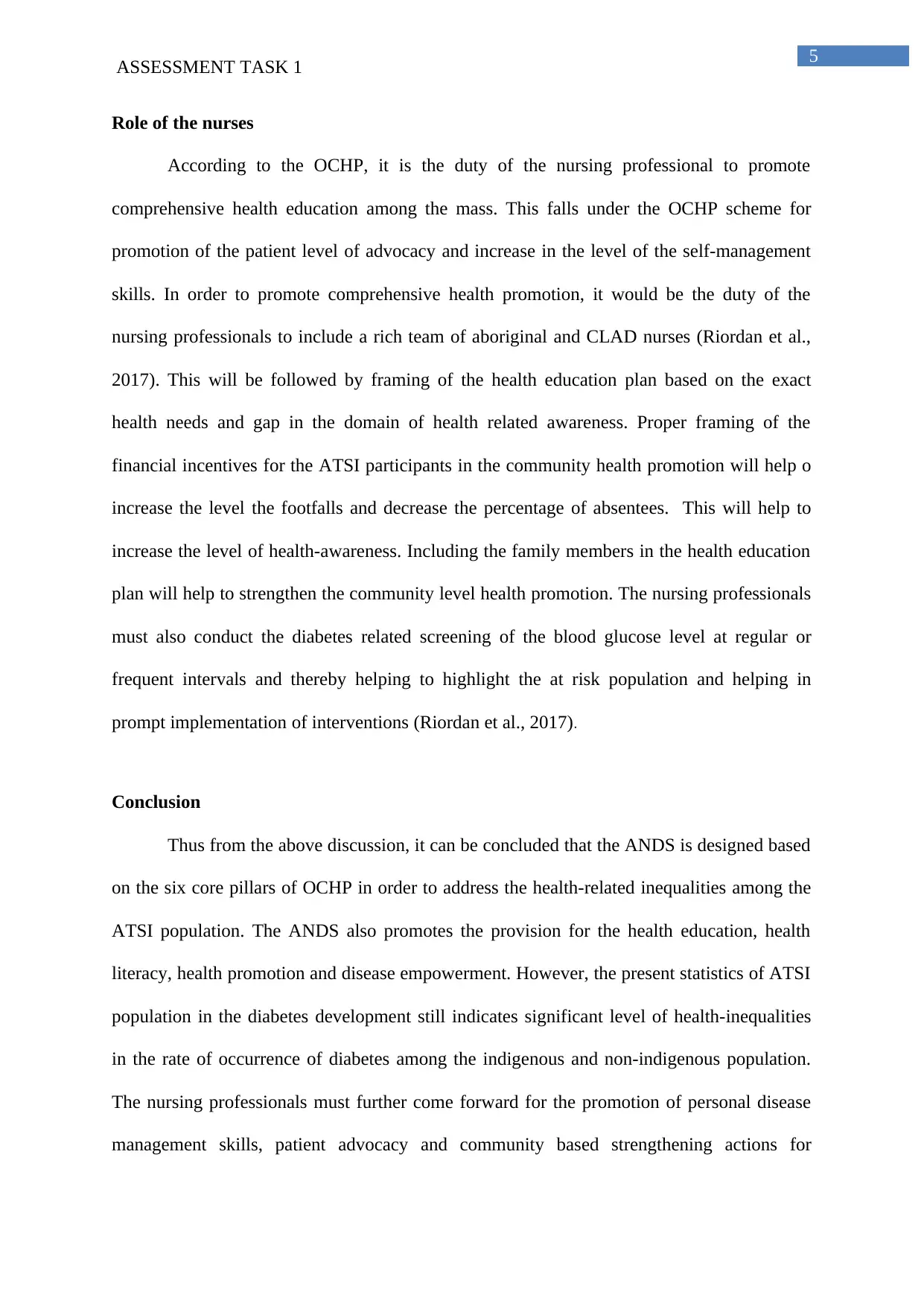
5
ASSESSMENT TASK 1
Role of the nurses
According to the OCHP, it is the duty of the nursing professional to promote
comprehensive health education among the mass. This falls under the OCHP scheme for
promotion of the patient level of advocacy and increase in the level of the self-management
skills. In order to promote comprehensive health promotion, it would be the duty of the
nursing professionals to include a rich team of aboriginal and CLAD nurses (Riordan et al.,
2017). This will be followed by framing of the health education plan based on the exact
health needs and gap in the domain of health related awareness. Proper framing of the
financial incentives for the ATSI participants in the community health promotion will help o
increase the level the footfalls and decrease the percentage of absentees. This will help to
increase the level of health-awareness. Including the family members in the health education
plan will help to strengthen the community level health promotion. The nursing professionals
must also conduct the diabetes related screening of the blood glucose level at regular or
frequent intervals and thereby helping to highlight the at risk population and helping in
prompt implementation of interventions (Riordan et al., 2017).
Conclusion
Thus from the above discussion, it can be concluded that the ANDS is designed based
on the six core pillars of OCHP in order to address the health-related inequalities among the
ATSI population. The ANDS also promotes the provision for the health education, health
literacy, health promotion and disease empowerment. However, the present statistics of ATSI
population in the diabetes development still indicates significant level of health-inequalities
in the rate of occurrence of diabetes among the indigenous and non-indigenous population.
The nursing professionals must further come forward for the promotion of personal disease
management skills, patient advocacy and community based strengthening actions for
ASSESSMENT TASK 1
Role of the nurses
According to the OCHP, it is the duty of the nursing professional to promote
comprehensive health education among the mass. This falls under the OCHP scheme for
promotion of the patient level of advocacy and increase in the level of the self-management
skills. In order to promote comprehensive health promotion, it would be the duty of the
nursing professionals to include a rich team of aboriginal and CLAD nurses (Riordan et al.,
2017). This will be followed by framing of the health education plan based on the exact
health needs and gap in the domain of health related awareness. Proper framing of the
financial incentives for the ATSI participants in the community health promotion will help o
increase the level the footfalls and decrease the percentage of absentees. This will help to
increase the level of health-awareness. Including the family members in the health education
plan will help to strengthen the community level health promotion. The nursing professionals
must also conduct the diabetes related screening of the blood glucose level at regular or
frequent intervals and thereby helping to highlight the at risk population and helping in
prompt implementation of interventions (Riordan et al., 2017).
Conclusion
Thus from the above discussion, it can be concluded that the ANDS is designed based
on the six core pillars of OCHP in order to address the health-related inequalities among the
ATSI population. The ANDS also promotes the provision for the health education, health
literacy, health promotion and disease empowerment. However, the present statistics of ATSI
population in the diabetes development still indicates significant level of health-inequalities
in the rate of occurrence of diabetes among the indigenous and non-indigenous population.
The nursing professionals must further come forward for the promotion of personal disease
management skills, patient advocacy and community based strengthening actions for
⊘ This is a preview!⊘
Do you want full access?
Subscribe today to unlock all pages.

Trusted by 1+ million students worldwide
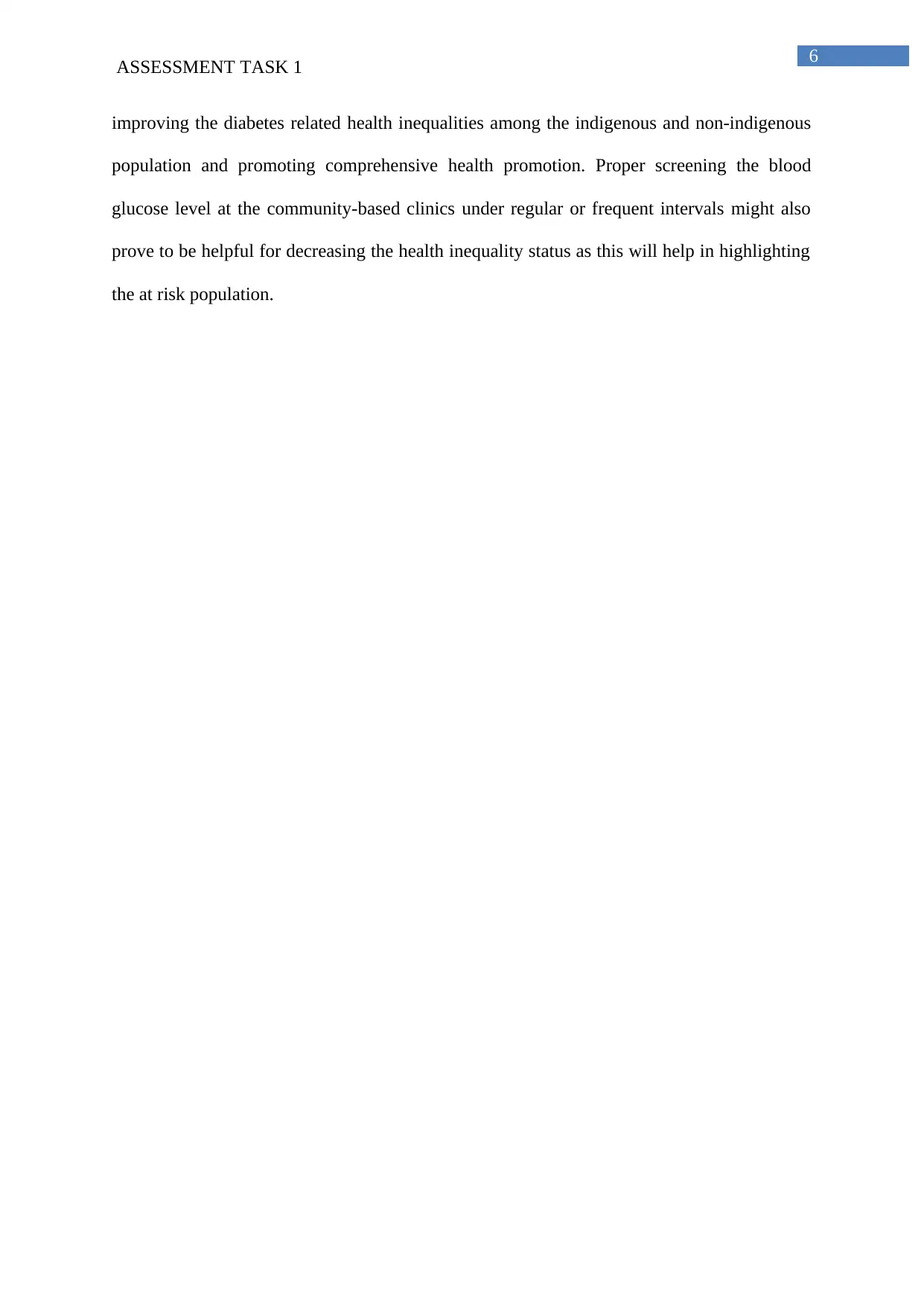
6
ASSESSMENT TASK 1
improving the diabetes related health inequalities among the indigenous and non-indigenous
population and promoting comprehensive health promotion. Proper screening the blood
glucose level at the community-based clinics under regular or frequent intervals might also
prove to be helpful for decreasing the health inequality status as this will help in highlighting
the at risk population.
ASSESSMENT TASK 1
improving the diabetes related health inequalities among the indigenous and non-indigenous
population and promoting comprehensive health promotion. Proper screening the blood
glucose level at the community-based clinics under regular or frequent intervals might also
prove to be helpful for decreasing the health inequality status as this will help in highlighting
the at risk population.
Paraphrase This Document
Need a fresh take? Get an instant paraphrase of this document with our AI Paraphraser
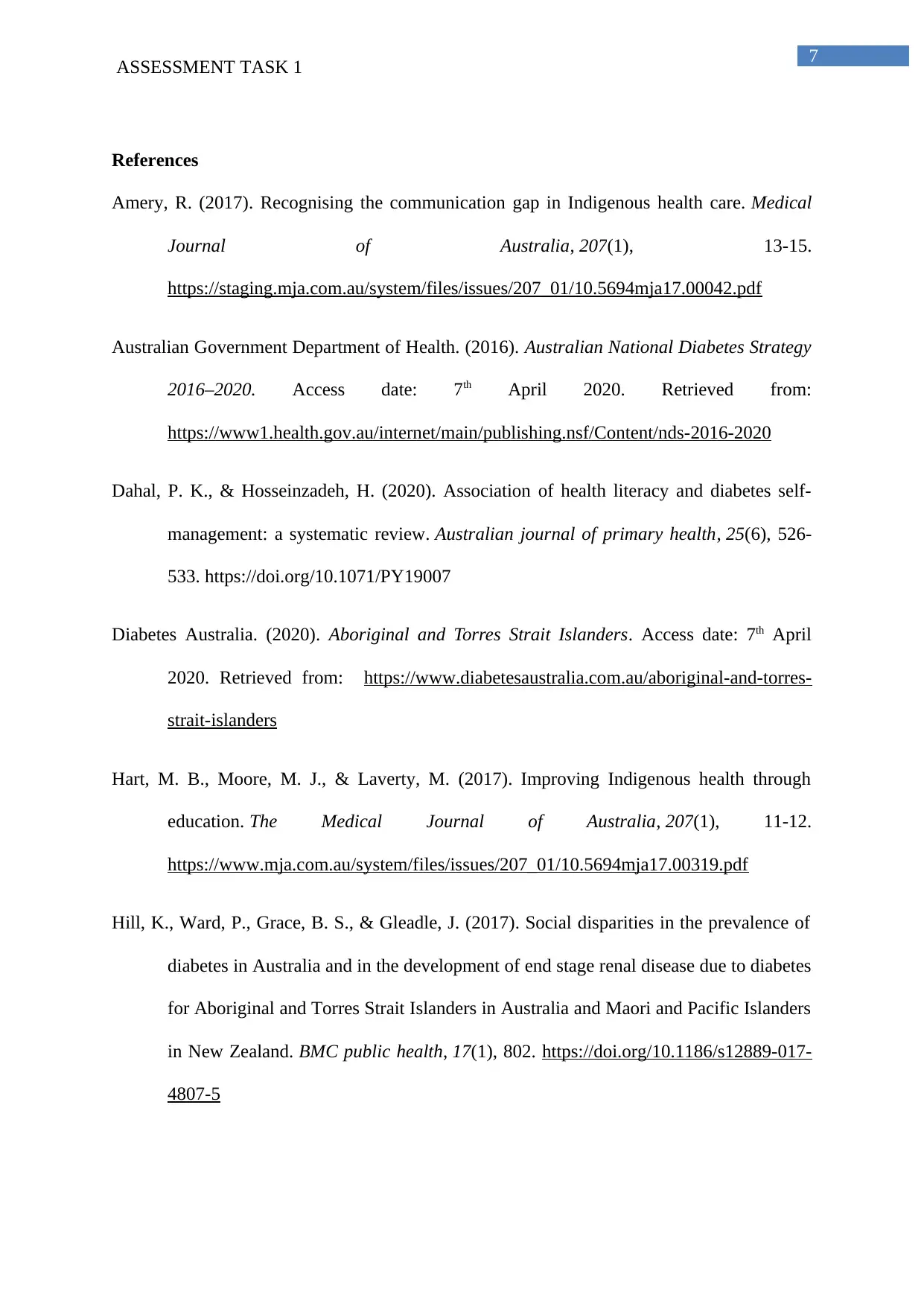
7
ASSESSMENT TASK 1
References
Amery, R. (2017). Recognising the communication gap in Indigenous health care. Medical
Journal of Australia, 207(1), 13-15.
https://staging.mja.com.au/system/files/issues/207_01/10.5694mja17.00042.pdf
Australian Government Department of Health. (2016). Australian National Diabetes Strategy
2016–2020. Access date: 7th April 2020. Retrieved from:
https://www1.health.gov.au/internet/main/publishing.nsf/Content/nds-2016-2020
Dahal, P. K., & Hosseinzadeh, H. (2020). Association of health literacy and diabetes self-
management: a systematic review. Australian journal of primary health, 25(6), 526-
533. https://doi.org/10.1071/PY19007
Diabetes Australia. (2020). Aboriginal and Torres Strait Islanders. Access date: 7th April
2020. Retrieved from: https://www.diabetesaustralia.com.au/aboriginal-and-torres-
strait-islanders
Hart, M. B., Moore, M. J., & Laverty, M. (2017). Improving Indigenous health through
education. The Medical Journal of Australia, 207(1), 11-12.
https://www.mja.com.au/system/files/issues/207_01/10.5694mja17.00319.pdf
Hill, K., Ward, P., Grace, B. S., & Gleadle, J. (2017). Social disparities in the prevalence of
diabetes in Australia and in the development of end stage renal disease due to diabetes
for Aboriginal and Torres Strait Islanders in Australia and Maori and Pacific Islanders
in New Zealand. BMC public health, 17(1), 802. https://doi.org/10.1186/s12889-017-
4807-5
ASSESSMENT TASK 1
References
Amery, R. (2017). Recognising the communication gap in Indigenous health care. Medical
Journal of Australia, 207(1), 13-15.
https://staging.mja.com.au/system/files/issues/207_01/10.5694mja17.00042.pdf
Australian Government Department of Health. (2016). Australian National Diabetes Strategy
2016–2020. Access date: 7th April 2020. Retrieved from:
https://www1.health.gov.au/internet/main/publishing.nsf/Content/nds-2016-2020
Dahal, P. K., & Hosseinzadeh, H. (2020). Association of health literacy and diabetes self-
management: a systematic review. Australian journal of primary health, 25(6), 526-
533. https://doi.org/10.1071/PY19007
Diabetes Australia. (2020). Aboriginal and Torres Strait Islanders. Access date: 7th April
2020. Retrieved from: https://www.diabetesaustralia.com.au/aboriginal-and-torres-
strait-islanders
Hart, M. B., Moore, M. J., & Laverty, M. (2017). Improving Indigenous health through
education. The Medical Journal of Australia, 207(1), 11-12.
https://www.mja.com.au/system/files/issues/207_01/10.5694mja17.00319.pdf
Hill, K., Ward, P., Grace, B. S., & Gleadle, J. (2017). Social disparities in the prevalence of
diabetes in Australia and in the development of end stage renal disease due to diabetes
for Aboriginal and Torres Strait Islanders in Australia and Maori and Pacific Islanders
in New Zealand. BMC public health, 17(1), 802. https://doi.org/10.1186/s12889-017-
4807-5
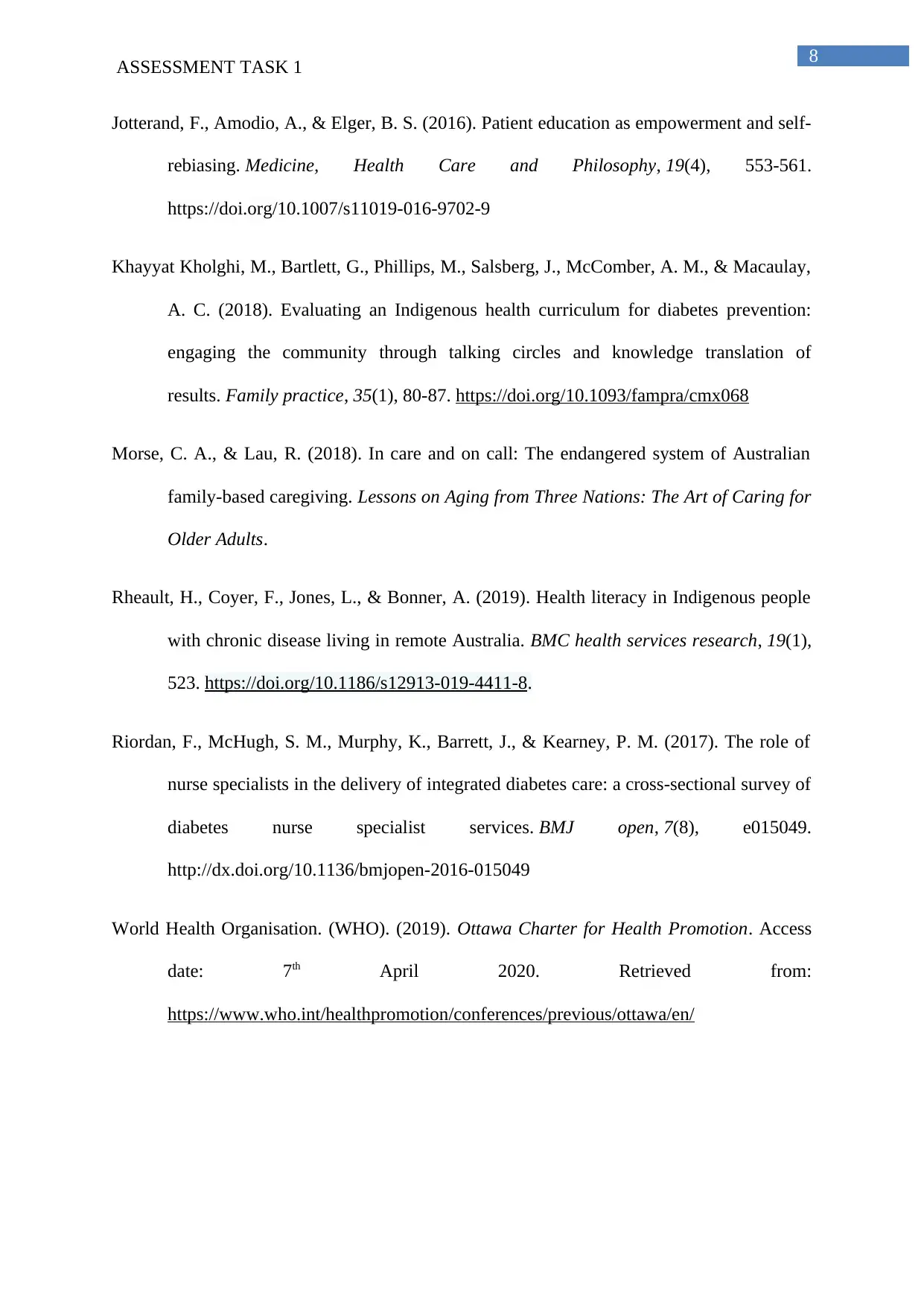
8
ASSESSMENT TASK 1
Jotterand, F., Amodio, A., & Elger, B. S. (2016). Patient education as empowerment and self-
rebiasing. Medicine, Health Care and Philosophy, 19(4), 553-561.
https://doi.org/10.1007/s11019-016-9702-9
Khayyat Kholghi, M., Bartlett, G., Phillips, M., Salsberg, J., McComber, A. M., & Macaulay,
A. C. (2018). Evaluating an Indigenous health curriculum for diabetes prevention:
engaging the community through talking circles and knowledge translation of
results. Family practice, 35(1), 80-87. https://doi.org/10.1093/fampra/cmx068
Morse, C. A., & Lau, R. (2018). In care and on call: The endangered system of Australian
family-based caregiving. Lessons on Aging from Three Nations: The Art of Caring for
Older Adults.
Rheault, H., Coyer, F., Jones, L., & Bonner, A. (2019). Health literacy in Indigenous people
with chronic disease living in remote Australia. BMC health services research, 19(1),
523. https://doi.org/10.1186/s12913-019-4411-8.
Riordan, F., McHugh, S. M., Murphy, K., Barrett, J., & Kearney, P. M. (2017). The role of
nurse specialists in the delivery of integrated diabetes care: a cross-sectional survey of
diabetes nurse specialist services. BMJ open, 7(8), e015049.
http://dx.doi.org/10.1136/bmjopen-2016-015049
World Health Organisation. (WHO). (2019). Ottawa Charter for Health Promotion. Access
date: 7th April 2020. Retrieved from:
https://www.who.int/healthpromotion/conferences/previous/ottawa/en/
ASSESSMENT TASK 1
Jotterand, F., Amodio, A., & Elger, B. S. (2016). Patient education as empowerment and self-
rebiasing. Medicine, Health Care and Philosophy, 19(4), 553-561.
https://doi.org/10.1007/s11019-016-9702-9
Khayyat Kholghi, M., Bartlett, G., Phillips, M., Salsberg, J., McComber, A. M., & Macaulay,
A. C. (2018). Evaluating an Indigenous health curriculum for diabetes prevention:
engaging the community through talking circles and knowledge translation of
results. Family practice, 35(1), 80-87. https://doi.org/10.1093/fampra/cmx068
Morse, C. A., & Lau, R. (2018). In care and on call: The endangered system of Australian
family-based caregiving. Lessons on Aging from Three Nations: The Art of Caring for
Older Adults.
Rheault, H., Coyer, F., Jones, L., & Bonner, A. (2019). Health literacy in Indigenous people
with chronic disease living in remote Australia. BMC health services research, 19(1),
523. https://doi.org/10.1186/s12913-019-4411-8.
Riordan, F., McHugh, S. M., Murphy, K., Barrett, J., & Kearney, P. M. (2017). The role of
nurse specialists in the delivery of integrated diabetes care: a cross-sectional survey of
diabetes nurse specialist services. BMJ open, 7(8), e015049.
http://dx.doi.org/10.1136/bmjopen-2016-015049
World Health Organisation. (WHO). (2019). Ottawa Charter for Health Promotion. Access
date: 7th April 2020. Retrieved from:
https://www.who.int/healthpromotion/conferences/previous/ottawa/en/
⊘ This is a preview!⊘
Do you want full access?
Subscribe today to unlock all pages.

Trusted by 1+ million students worldwide
1 out of 9
Related Documents
Your All-in-One AI-Powered Toolkit for Academic Success.
+13062052269
info@desklib.com
Available 24*7 on WhatsApp / Email
![[object Object]](/_next/static/media/star-bottom.7253800d.svg)
Unlock your academic potential
Copyright © 2020–2025 A2Z Services. All Rights Reserved. Developed and managed by ZUCOL.





